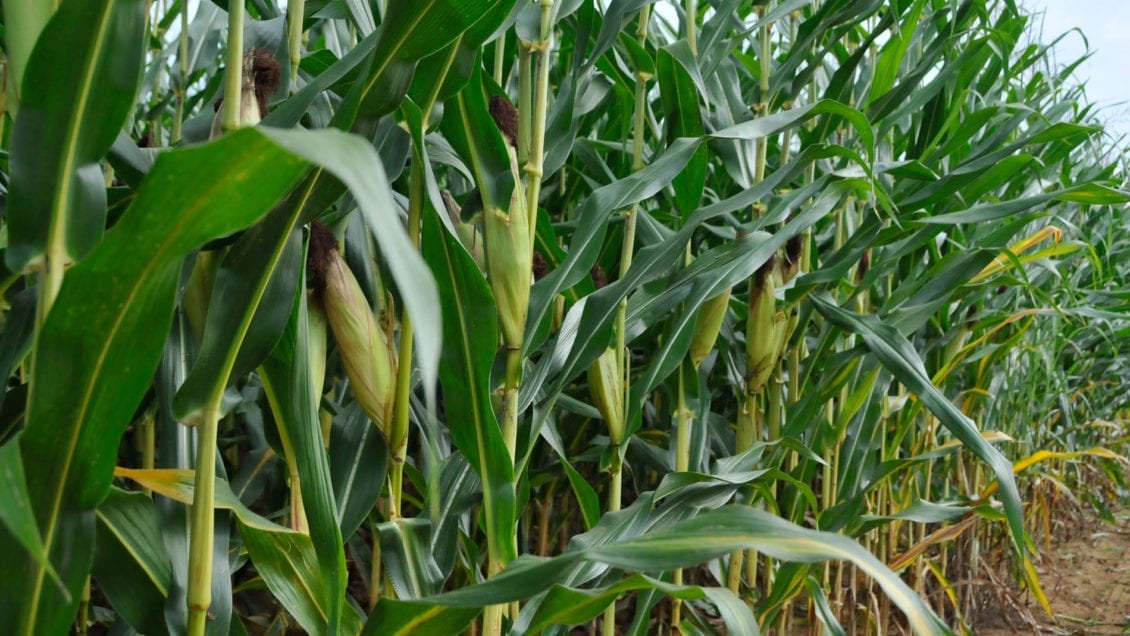Stalk Lodging In Corn
Lodging in Corn. 2018 harvest in US Corn belt is showing some lodging problems.
Severely lodged corn leads to increased harvest lossesincreased harvest time increased drying cost and may result involunteer corn the following year.

Stalk lodging in corn. Grain moisture levels may also be unacceptably high in lodged corn. An Iowa State study forced V10-stage corn to lodge at a 45 angle in plots with and without rootworms. As farmers start harvesting earlier planted corn fields those typically planted in mid May or earlier they often encountered stalk lodging especially in fields that received little or no rain.
This study presents results from a structural engineering failure analysis of corn stalk lodging. Range between 5 and 25. Stalk lodging in corn occurs when the stalk weakens and breaks at some point below the ear Figure 1.
Stalk lodging by definition is the breakage of the stalk below theear. Corn stalk rots and lodging are usually the result of an interaction between weather fertility compaction leaf disease plant population planting date and kernel fill. The disease has been reported as causing a 30-40 bushel per acre or more yield reduction in areas of corn fields that have been heavily infected with the disease.
Corn stalk rots and lodging are usually the result of an interaction between weatherfertility compaction leaf disease plant population planting date and kernel fill. It was therefore hypothesized that application of structural and forensic engineering principles would provide novel insights into the problem of late-season stalk lodging of maize Zea mays L. High winds stalk cannibalization and stalk rots.
Cannibalization predisposes corn plants to stalk rots and lodging Figure 1. When this occurs it results in harvest losses and slows down harvesting considerably. It also is being spotted on combine yield monitors as pockets of reduced yields in fields.
The presence of stalk rots in corn may not always result in stalk lodging especially if the affected crop is harvest promptly. Its not uncommon to walk corn fields where nearly every plant is upright yet nearly every plant is also showing stalk rot symptoms. You might see the impacts of the disease in your fields as pockets of unusually heavy stalk lodging.
Ad Best Price Guarantee. Grain yield of lodged corn without rootworms yielded 11 and 40 percent less than the control in the two years of the study while lodged corn with rootworms yielded 12 and 28 percent of the control. Lodging may occur near the crown above or below the ear and sometimes higher in the stalk.
Analysis of causes should begin with distinguishing between what is called root lodging and that named as stalk lodging. Grain moisture levels may also be unacceptably high in lodged corn. Stalk lodging breakage of plant stems prior to harvest is a major problem for both farmers and plant breeders.
Stalk lodging presents itself worse in some years than others and this is one of those years. Ad Best Price Guarantee. Flexural Stiffness Predicts Strength In this laboratory-based experimental study we identify stalk flexural stiffness as a new mechanical predictor for corn stalk strength that significantly outperforms existing metrics used in the industry.
Annual yield losses due to stalklodging in the US. Severe weather during dry down can be a primary or contributing cause of stalk lodging. Stalk lodging in corn occurs when the stalk weakens and breaks at some point below the ear Figure 1.
-Lodging can complicate corn harvest and may lead to yield loss and problems with grain storage. Originally written February 1 2006 Last updated September 6 2018. Maize stalk lodging is defined as the breakage at or below the ear which makes up more than 60 of lodging cases in a dense population resulting in a major issue in modern maize production.
When this occurs it results in harvest losses and slows down harvesting considerably. It causes annual yield losses of up to 75 3 4 5 6 reduces grain quality 7. For a corn plant to remain healthy and free of stalk rot the plant must produce enough carbohydrates by photosynthesis to keep root cells and pith cells in the stalk alive and enough to meet demands for grain fill.
Stalk rots are favored by good early-season growing conditions followed by stress after pollination. Stalk lodging is essentially a structural failure. Previous methods of phenotyping stalk strength induce failure patterns different from those observed in natural lodging events.
When corn is subjected to stress during grainfill photosynthetic activity is reduced. There are a number of factors that can contribute to stalk lodging in corn but it is most commonly associated with a combination of weakened stalks due to some sort of stress during grain fill and stalk rot pathogens that subsequently invade the weakened stalks. For a corn plant to remain healthy and free of stalk rot the plant.
Stalk Cannibalization in Corn Stalk cannibalization remobilization of sugars from the stalks to fill the kernels resulting in reduced carbohydrate content in the stalks is the cause of many weakened corn plants that may be found in a field at the end of the season. Root lodging generally occurs anytime during the growing season when the lateral roots of the plant are insufficient to avoid the plant leaning when faced with winds. There are several factors to consider that lead to stalk lodging.
A limiting factor in addressing this problem is the lack of a reliable method for phenotyping stalk strength. Stresses can include drought nutrient deficiencies foliar diseases hail. Pathological stalk lodging can be caused by the presence of one or more stalk rot diseases.
-Ear drooping and stalk lodging may be caused by different factors including. Causes of Corn Stalk Lodging and Management.

Stronger Corn Stalks Could Lead To Greater Food Security

Agronomy Eupdate September 20th 2019 Issue 766

Stalk Quality Concerns Widespread Morning Ag Clips

Posting Komentar untuk "Stalk Lodging In Corn"